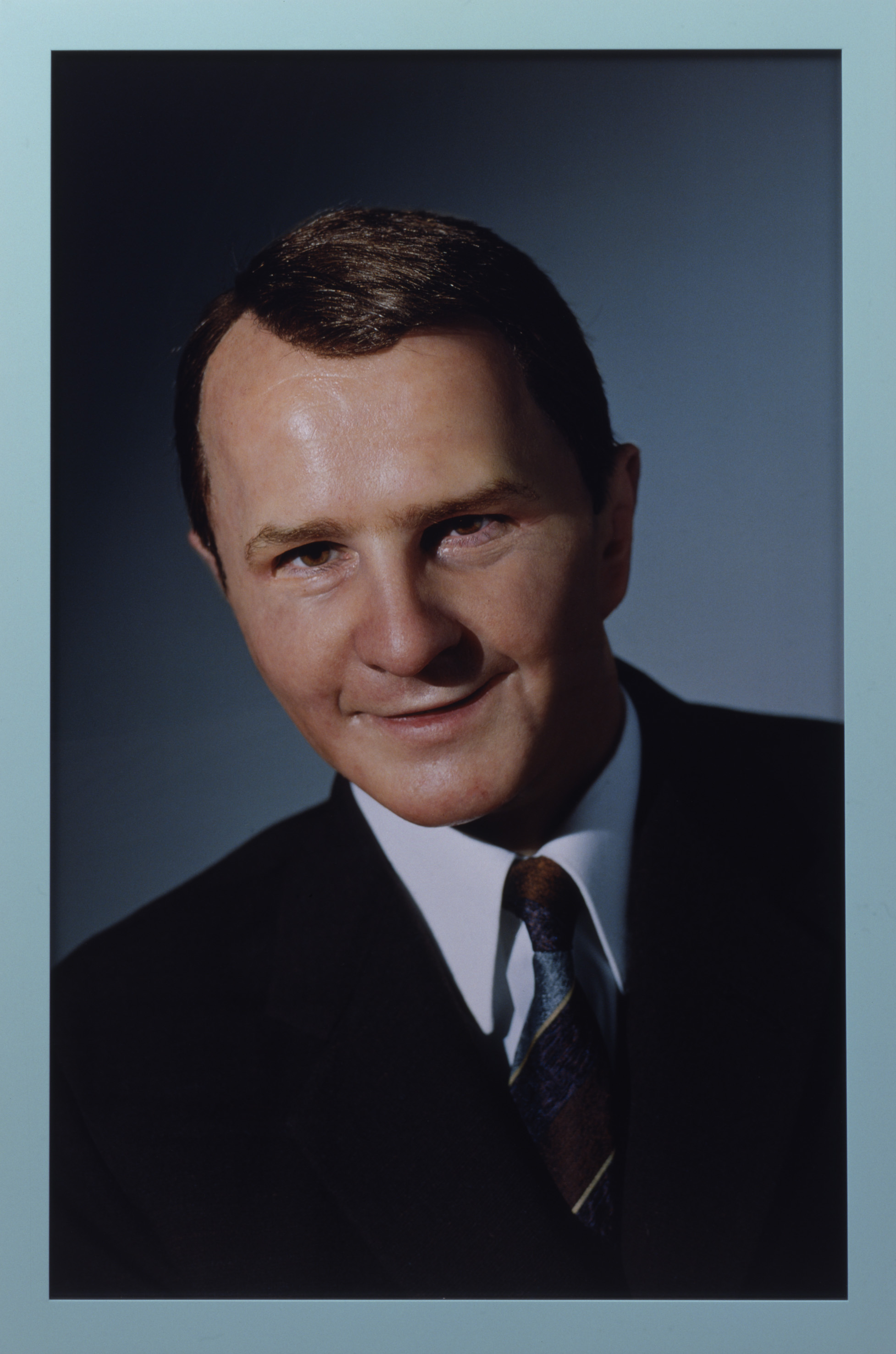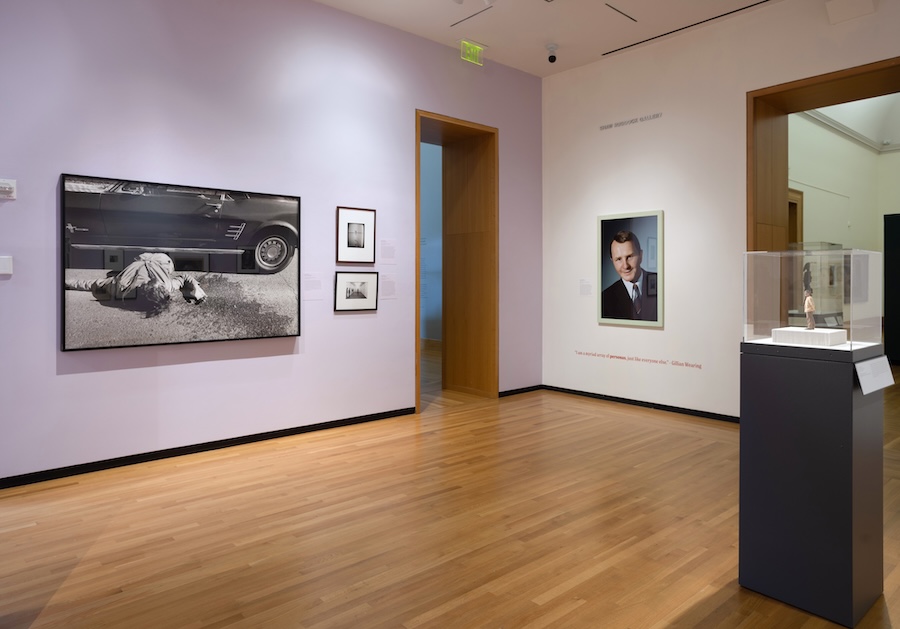Object of the Month: “Self-Portrait as My Uncle Bryan Gregory” (2003) by Gillian Wearing
By Bowdoin College Museum of Art
Gillian Wearing, Self Portrait as My Uncle Bryan Gregory, 2003, framed c-type print, 48 7/8 x 32 1/2 inches; 124 x 82.5 cm. Edition of 6; 2APs. Bowdoin College Museum of Art, Brunswick, Maine. Gift of David and Gail Mixer, 2024.25.202. Courtesy of the artist, Maureen Paley, London, Tanya Bonakdar Gallery, New York / Los Angeles, and Regen Projects, Los Angeles
When I first encountered Gillian Wearing’s Self-Portrait as My Uncle Bryan Gregory, I wasn’t sure what to do with it. It seems plainspoken enough, a weirdly normal glossy corporate headshot in a stack of more blatantly audacious and experimental portraiture that would come to be in the exhibition Hello, Stranger: Artist as Subject in Photographic Portraits since 1900. Something in its unassuming nature was off-putting, demanded answers, and so I indulged it.
In an elaborate feat of masquerade, Wearing—one of the notoriously experimental Young British Artists who first made their mark in the late 1980s and early 1990s—costumes and contorts her body into a likeness of her uncle. In assuming the appearance of another, she seemingly elides the crucial element of the self in self-portraiture. The cliché that the eyes are the windows to the soul lives into its full ironic truth here. Upon face-to-face inspection, a rift between the mass of the face and the skin around the eyes comes into focus. Cloaked in the plasticky artifice of a silicone mask, the viewer comes to realize, it is Wearing’s gaze that meets our own, altered beyond recognition by elaborate costuming and makeup.
A part of her Album series, this work is uniquely personal among her other forays into masquerade. Drawing from her own family archives, she raises pointed questions about genetic destiny, and how much of ourselves we owe to who we come from. In another series, she calls outward to artistic ancestors who similarly engage in transgressive performances of self, notably early French lesbian photographer Claude Cahun.
Though the titles employed by Wearing—Self-Portrait as My Uncle Bryan Gregory or “Self-portrait as [her mother and sister, even herself as a teenager]”—betray these works’ main conceit, her significant commentary on identity construction merits further unraveling. Central to Wearing’s practice is empathetic human connection through the depiction of others. By knowing others more intimately—recreating each crinkle of skin around the eye, feeling the contortion of a forced smile—she returns to a better knowledge of herself as fundamentally a product of her relations. When asked about the presence of “the real Gillian Wearing” in her work, she retorted, “I am a myriad array of personas, just like everyone else.”
With the scale of the photograph at a staggering 4 feet by 3 feet, Wearing’s uncanny presence looms large in the gallery. The size is atypical for traditional photographic prints, and its larger-than-life proportions adds to the theatricality of the work. Though technologically a far cry from one of the world’s first photographs, Hippolyte Bayard’s grainy and petite (likely 4x6) Self-Portrait as A Drowned Man, both works interestingly operate within the same conceptual space of autobiographical fiction, despite the visible centuries elapsed between their creation.
And though it lacks the explicit queerness of other examples of cross-dressing on display in Hello, Stranger (notably, Pierre Molinier’s Transvestite Self-Portrait), Wearing’s work nonetheless speaks to a similar notion of performativity before the camera’s eye. Indeed, it is the body—as a quality of material being—that brings together Hello, Stranger: its presence or supposed absence and the slippages in the interchange between photographic technology and the reality it mediates.
In the contemporary digital sphere, saturated with artificially constructed representations, self-image feels especially relevant. Though a far cry from the instantaneity and fake-casual performance of the selfie, Wearing’s work nonetheless confronts us with our own material myths of self. Who are we in front of the camera? How do we re-present ourselves to the myriad gazes we find ourselves subject to, a consequence of our societal self-obsession? In Wearing’s words, “We are all performers, we perform ideas of ourselves in our heads, project our future selves,” and a uniquely self-conscious process of becoming unfolds in the sight of the camera. Proceed with caution, as appearances can be deceiving.
Self-Portrait As My Uncle Bryan Gregory was welcomed into the BCMA’s collections last summer as part of a generous gift by David and Gail Mixer of over 200 portrait photographs. Selections from this collection, including Wearing’s portrait, comprise Hello, Stranger: Photographic Portraiture Since 1900, which is on view in the Shaw Ruddock Gallery through August 10, 2025.
Isa Cruz ’27Co-curator of Hello, Stranger: Artist as Subject in Photographic Portraits since 1900
